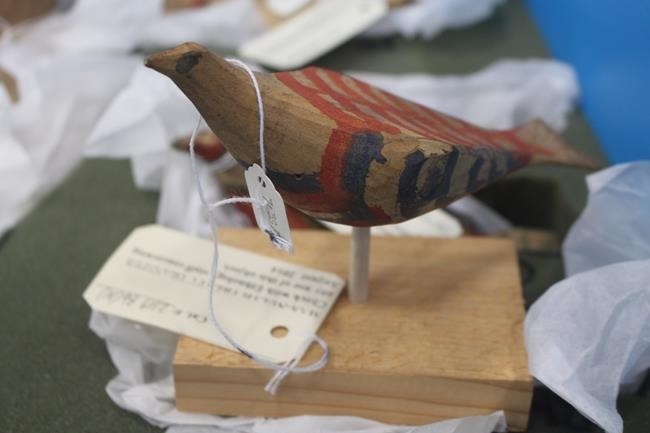
Artwork is on display at the Huu-ay-aht First Nation's Assembly in Port Alberni, B.C., in this recent handout photo. Huu-ay-aht First Nation on Vancouver Island is celebrating the repatriation of their cultural treasures, an act Chief Councillor Robert Dennis Sr. says proves that historic practices to erase indigenous cultures were resisted.
Image Credit: THE CANADIAN PRESS/HO - Huu-ay-aht First Nations, Heather Thomson *MANDATORY CREDIT*
November 20, 2016 - 10:30 AM
PORT ALBERNI, B.C. - A five-metre-wide painted wood screen and 37 hand-carved birds are among a collection of artwork returned to a First Nation after more than a century in the Royal B.C. Museum.
Huu-ay-aht First Nation on Vancouver Island is celebrating the repatriation of their cultural treasures, an act Chief Councillor Robert Dennis Sr. says proves that historic practices to erase indigenous cultures were resisted.
"We're resilient, we're strong and our culture is still alive," Dennis said in an interview.
The transfer of 17 sets of artifacts from the museum to the Huu-ay-aht on Friday is a result of a 2011 agreement reached between Maa-nulth First Nations and provincial and federal governments outlining rights to land, resources and other property, including cultural artifacts.
Dennis said the physical and legal transfer of the artifacts is an important part of reconciliation.
The items, which also include thunderbird masks and ceremonial whaling regalia, were on display during the Huu-ay-aht People's Assembly in Port Alberni this weekend.
Some of the items are unlike anything the community has had in its possession in recent years, Dennis said, because so much of the First Nation's historic property was either sold or lost.
The practice of creating large painted screens for ceremonies or homes is still maintained, but Dennis said instead of wooden planks, cloth or canvas is now more commonly used as the backdrop.
The Huu-ay-aht's traditional practices were undermined and banned through the Residential School system and other policies, including a federal potlatch ban that prohibited indigenous ceremonies.
"That is the sad part of Canadian history," Dennis said.
Anthropologist and consultant Kevin Neary said the original owners likely donated the items to the museum in an attempt to protect the artwork from being confiscated and destroyed.
"For this screen to have come to the museum was a way of preserving it ... perhaps even with the view that at some point it may come back to the community, something that would be like putting it into a bank so that later on you could get it back," Neary said.
Seeing the items returned this weekend was bittersweet for many in the community, serving as a reminder of what was lost.
"There is sadness in the fact that our forefathers had to give up part of their tradition and their culture," Dennis said.
For the First Nation's hereditary chiefs and elders, seeing the items returned was a particularly emotional experience because they were more directly affected by the policies that banned their traditions, he said.
There has been a push to revive the Huu-ay-aht's history and language in recent years, including translating materials and writing books to document information that is still available.
Dennis said he hopes the return of the cultural artifacts will inspire the community to do more to revive its history, art and language.
Neary, who worked at the Royal B.C. Museum in the 1970s and 1980s, said as indigenous items were put on display for the public, First Nations were also able to see their artistic heritage which inspired a new wave of artists.
Compared to 40 or 50 years ago, there are many more First Nations artists practising today, Neary said.
The artifacts will be placed on display at the Huu-ay-aht Government Office in Anacla, near Bamfield, on the west coast of Vancouver Island.
Dennis said the First Nation is planning to build a cultural interpretation centre and museum which he hopes will be approved for funding next year.
Once the centre is constructed, Dennis said the Huu-ay-aht will request the return of other artifacts from the Royal B.C. Museum.
News from © The Canadian Press, 2016